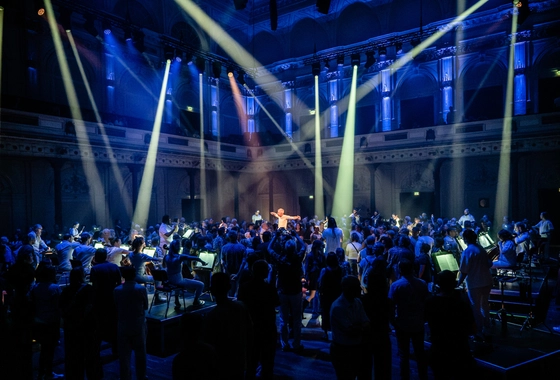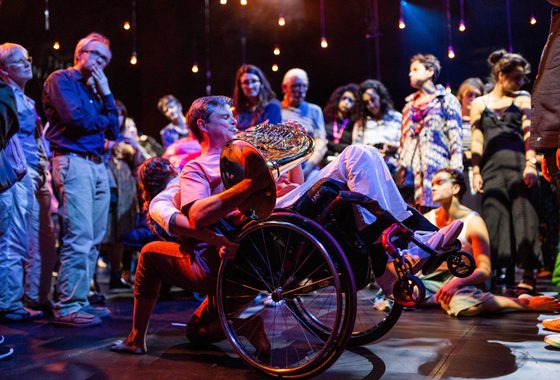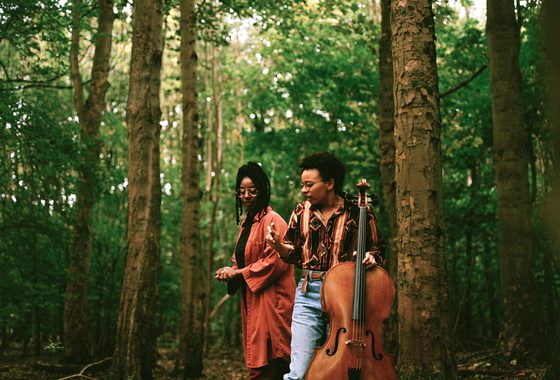Our new braille music course
News Story
Virtuoso recorder player and long-standing member of our ensemble James Risdon introduces the braille music course he has been leading as part of Paraorchestra's artist development programme Modulate

Paraorchestra is no regular orchestra – and that is not just because of the genre-busting, expectation-defying shows it creates.
The Modulate programme of professional development, including talks, workshops, training courses and opportunities to develop artistic practice is as bold and spectacular as any of its live performances. This makes it a thrilling and enriching place to be as a musician.
For many years, Paraorchestra have actively helped with the production of scores in accessible formats, including commissioning braille music transcriptions. While this might seem a simple principle of equality, it is far from common practice.
In the last two years, The Daisy Consortium’s braille music project has brought about significant developments in the field of automated braille music transcription. The results include best practice guidelines for music engravers, engagement with major publishers to provide MusicXML files of their scores, user-defined requirements for braille music translation tools and ongoing work to develop their accuracy and availability. The result is a transformation of the whole global ecosystem of braille music. As a blind musician, this suite of work has delivered results that are as rapid as they are transformational. In the year we celebrate the 200th anniversary of Louis Braille’s invention, it is fitting that Paraorchestra invited me to share these developments with the visually impaired musicians in the Paraorchestra family.
The result was a short course entitled "Five Lines to Six Dots in Three Weeks."
It is far from common practice to have braille scores provided for professional engagements.
James Risdon
Week One
Week one focussed on existing sources of braille music scores. These include the many libraries of braille music around the world, each with tantalising collections of scores transcribed by dedicated specialists, immaculately bound and hand-stitched. 21st century iterations include the Braille Music Transcription Server (BrailleMuse) project produced by the University of Yokohama, and the incomparable Brailleorch project produced by surely the world’s most prolific braille music producer, Haipeng Hu. We also considered the pros and cons of using dictation, commissioning a new transcription or finding scores on mainstream sites such as IMSLP and MuseScore.com and converting these into braille.
Our guest speaker was the Portuguese pianist Jorge Goncalves who has lived, worked and studied across Europe, mining all the braille music he can from Lisbon to Warsaw via Paris and Monza. Jorge’s tenacity, passion and talent are combining in a PhD focussing on performance practice in 19th century piano music.
Week Two
For week two, we took a deep dive into the tools to convert print into braille music. Ahead of Paraorchestra’s historic Proms debut with The Virtuous Circle, we used Mozart’s exquisite 40th symphony as our test piece. Starting with a freely-available file on MuseScore.org, we produced braille versions using SMB Braille Music converter, Makebraille from the German Central Library for the Blind, Goodfeel Braille Music Translator from Dancing Dots and finally from the BrailleMuse collection.
Rather than a step-by-step tutorial, we considered the merits of each tool, from the perspective of cost, ease of use, technical support and accuracy.
It would have been difficult to design a better guest speaker for this session in a laboratory. James Bowden is RNIB’s braille Technical Officer with a degree in computer science from Cambridge. As well as very deep knowledge about computers and braille, he is a pianist and organist. Among his achievements are the Quick Windows Sequencer for writing Midi, and two recorder concerti that would win prizes for Baroque pasticherie if such existed.
James is also the main author of a recent comprehensive guide to automated braille music transcription which supplemented this session.

Week Three
The final week was a chance to consider how to put all this into practice for real-life situations. We considered workflows for creating braille music and how to refine these for the purposes of familiarisation, memorisation and use in rehearsals and performance. Despite all the advances in technology and availability, braille music does not offer the same instant overview that is possible when looking at a printed score. We considered how to further edit a score so that phrases, sequences, patterns, sections and repeats are as obvious as possible. In the time-bound rehearsal, it’s important to have a score where musical features are easy to find quickly. We touched on the pros and cons of having music electronically or on paper, how to capture rehearsal notes and even how to deal with graphic scores.
Our guest speaker was Dr. Sarah Morley Wilkins, the Project manager for the Braille Music Project mentioned above. Sarah gave an overview of her work and shared the published guidelines for composers and arrangers.
Summary
As blind musicians, we are even more reliant on technology than others. It can be difficult to set aside the necessary time and energy to master music technology - especially when there is a piece to learn, a gig to prepare. This series gave us each the time and space to consider a new world of musical potential. I hope it was also a chance for valuable peer to peer support and shared learning.
Many thanks to Paraorchestra for asking me to lead this series.
James Risdon
James Risdon has been a member of Paraorchestra since its earliest incarnation and features in several recent recordings and projects. He worked for nearly a decade in the RNIB Music Advisory Service and since 2017 has been the Access Lead at ABRSM as well as maintaining varied freelance work as a recorder player.



